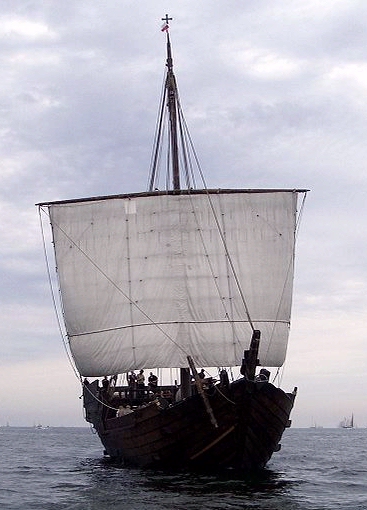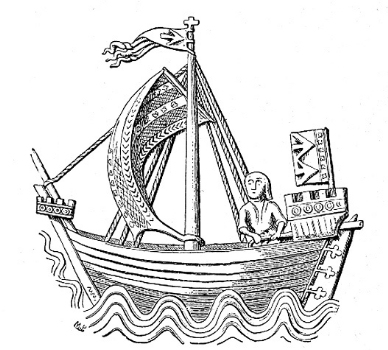
The German replica Kieler Hansekogge 2007 seen from the front (Source: Wiki Commons).
The ancient cogs were in use between 1200 - 1500 in Northern Europe (the Hansa era).
The term "cog" and what type of ship it is used for is of course quite vague. With only two
originals preserved, we can only speculate about the line of developement. Researchers state
that until 1200, the "types" of Viking Ships was gradually
transformed to the "cog" and/or the "hulc" - those were almost synonyms then. The contemporary iconography shows
a variety of different "cogs" (size, masting, rigging).
The first cogs were single masted, later cogs had fore and poop castles, and up to 3 masts,
as seen from the ancient iconography.
|
At least, there are some VERY rare wrecks rediscovered around 1950 by underwater archeology.
So, we know at least something about the hull and its construction. The rigging of course, did not prevail ...
Then we have some rare depictions, from the ancient iconography on coins and other historic relics:

Kogge Stralsund (Source: Wiki Commons)
No original masts are fully preserved.
The masts were fixed in the keel and was too high to stand alone without a minimum of a stay and two backstays.
Depictions show about 3-6 backstays. They were the first true standing rigging in Northern history.
Each mast carried only one sail. The square sail must have had at least a halyard, some kind of port and starboard braces and sheets.
From the mere physical point of view, it was obviously possible to swing the yard from +80 to -80 degrees, in other words,
this square sail could be used to sail "large", as well as a for-and-aft sail, and go very closed to the wind, like a schooner,
even not as well as for the Viking ships.
(Staysails are not "reported"; those came up after 1700, on the Ships of The Line)
We can assume that, in order to set or furl the sail (they had only one), the yard was hauled up or veered down to deck.
Topping lifts were not necessary, at least we have no evidence for them.
This is all we know.
|

